

HITLER STRIKES OUT
Local Flyboys Played America’s Game with History’s Highest Stakes—Fool the Nazis
By Don Knaus

The Band Plays on in Corning Shacking Up with Hunters in PA Warriors Help Warriors Hunt in Potter County

41st Annual

Saturday, December 6 Main Street,
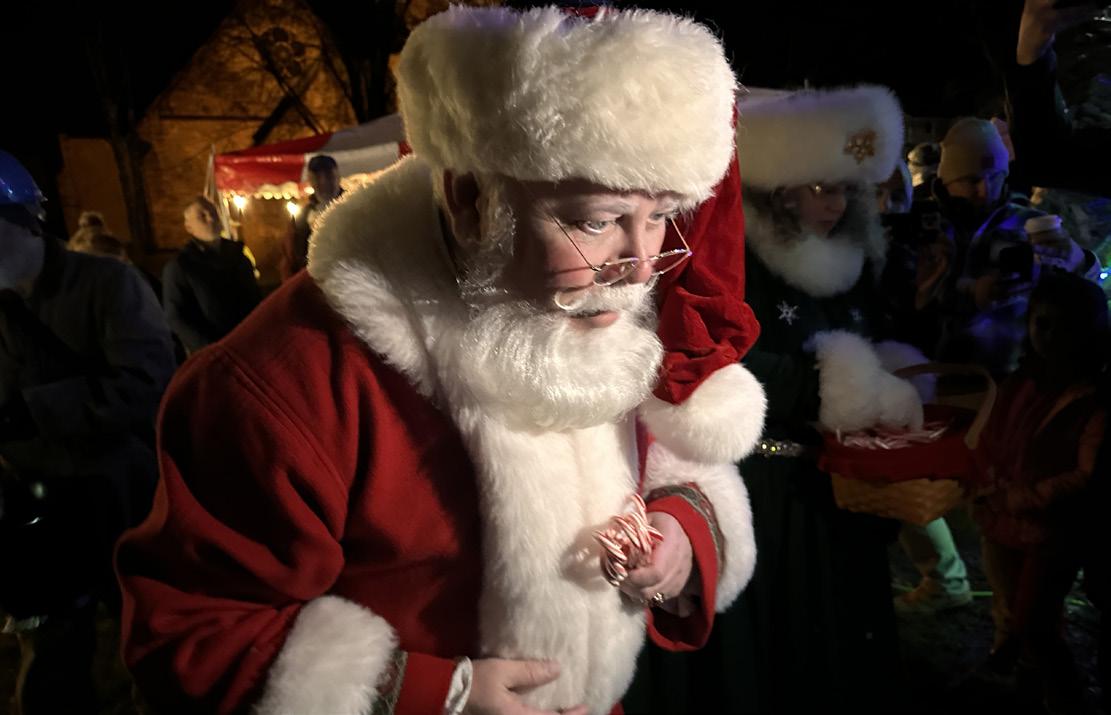
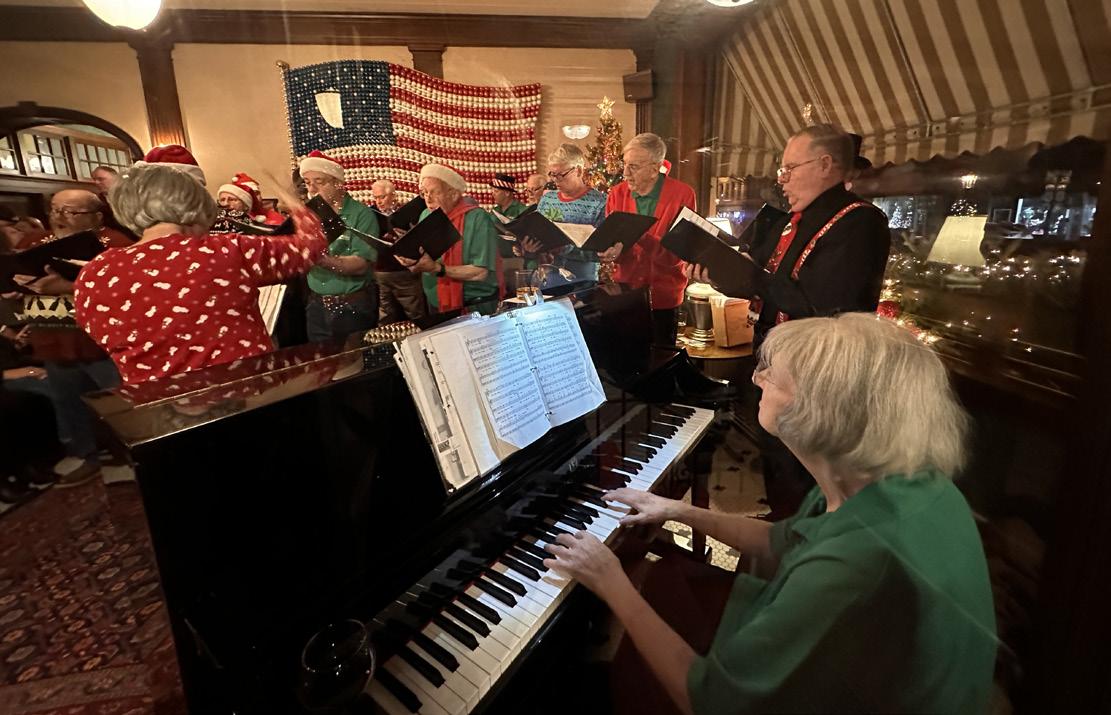
9am-4pm Craft Show & Food, Fireman’s Annex 9am-5pm Indoor Craft Show & Food, Tioga County Active Living Center
9:30am Wellsboro High School Dickens Choir, Arcadia Theatre
9:30am-11:30am Christine A. Moore Millinery/ HomePage Network, Best Dressed Showcase Registration, Deane Center
10am Victorian Stroll, Deane Center Outdoor Stage
10am-2pm Alternative Giving Christmas Fair, Refreshments, & Music, First Presbyterian Church
10:30am HG Productions, “A Christmas Carol,” Deane Center 11am HG Productions, “A Christmas Carol,” Warehouse Theatre 11am Dickens Sing-a-long, First Baptist Church
11am-2pm Indoor Book Sale & Basket Raffle, First Baptist Church 1pm HG Productions, “A Christmas Carol,” Warehouse Theatre 1pm Christine A. Moore Millinery/ HomePage Network Best Dressed Showcase, Deane Center Outdoor Stage 1pm Dickens Sing-a-long, First Baptist Church
1:30pm HG Productions, “A Christmas Carol,” Deane Center 2pm Victorian Stroll, Deane Center Outdoor Stage 2pm Wellsboro Women’s Chorus, United Methodist Church 2:30pm Wellsboro Men’s Chorus, Arcadia Theatre
3:30pm HG Productions, “A Christmas Carol,” Deane Center 4pm HG Productions, “A Christmas Carol,” Warehouse Theatre 4pm Choral Evensong Service, St. Paul’s Episcopal Church 5pm Candlelight Walk for Peace, Packer Park to The Green
5:30pm Tree Lighting Ceremony, The Green







Teresa Banik Capuzzo
David Higgins
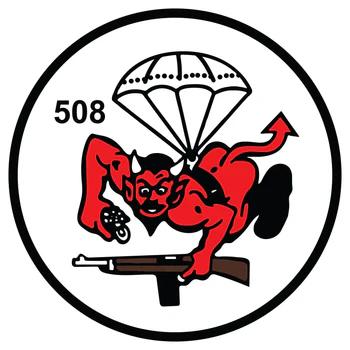
Lilace Mellin Guignard
Chris Espenshade
Matthew Stevens


By Don Knaus
Local flyboys played America’s game with history’s highest stakes— fool the Nazis.
By Paula Piatt
Jim Hyland
Cover illustration by David Higgins. This page (top) The Red Devils logo; (middle) Guide Rich Brandon with Veteran Mike Doyle courtesy LEEK Hunting Preserve; (bottom) Asaph CCC Camp courtesy Jim Hyland.


mountainhomemag.com
E ditors & P ublish E rs
Teresa Banik Capuzzo
Michael Capuzzo
A ssoci A t E E ditor & P ublish E r
Lilace Mellin Guignard
A ssoci A t E P ublish E r
George Bochetto, Esq.
A rt d ir E ctor
Wade Spencer
M A n A ging E ditor
Gayle Morrow
s A l E s r EP r E s E nt A tiv E
Shelly Moore
c ircul A tion d ir E ctor
Michael Banik
A ccounting
Amy Packard
c ov E r d E sign
David Higgins, Wade Spencer
c ontributing W rit E rs
Chris Espenshade, David Higgins, Jim Hyland, Don Knaus, Paula Piatt, Matthew Stevens
c ontributing P hotogr AP h E rs
Chris Espenshade, Linda Stager, Matthew Stevens d istribution t EAM
Dawn Litzelman, Grapevine Distribution, Linda Roller
t h E b EA gl E Nano
Cosmo (1996-2014) • Yogi (2004-2018)










ABOUT US: Mountain Home is the award-winning regional magazine of PA and NY with more than 100,000 readers. The magazine has been published monthly, since 2005, by Beagle Media, LLC, 39 Water Street, Wellsboro, Pennsylvania, 16901, online at mountainhomemag.com or at issuu.com/mountainhome. Copyright © 2025 Beagle Media, LLC. All rights reserved. E-mail story ideas to editorial@ mountainhomemag.com, or call (570) 724-3838.
TO ADVERTISE: E-mail info@mountainhomemag.com, or call us at (570) 724-3838.
AWARDS: Mountain Home has won over 100 international and statewide journalism awards from the International Regional Magazine Association and the Pennsylvania NewsMedia Association for excellence in writing, photography, and design. DISTRIBUTION: Mountain Home is available “Free as the Wind” at hundreds of locations in Tioga, Potter, Bradford, Lycoming, Union, and Clinton counties in PA and Steuben, Chemung, Schuyler, Yates, Seneca, Tioga, and Ontario counties in NY.
SUBSCRIPTIONS: For a one-year subscription (12 issues), send $24.95, payable to Beagle Media LLC, 39 Water Street, Wellsboro, PA 16901 or visit mountainhomemag.com..


Last Great Place


Magazine on Fire
By Teresa Banik Capuzzo
Our favorite column to write each year is when we celebrate our award-winning writers and photographers, and it is that time! Between the Keystones (awarded by the Pennsylvania NewsMedia Association) and the IRMAS (awarded by the International Regional Magazine Association), eight Mountain Home writers and photographers won us eleven awards. Four IRMAS. Seven Keystones. Three for photos. Seven for stories. And one for catchy headlines.
We have been burning to brag over our photographers whose Back of the Mountain photos swept the Feature Photo category for Division V (non-daily news publications with a distribution over 5,000). Some of our main competitors are TheBurg, Bucks County Herald, and the New Pittsburgh Courier. Curt Weinhold’s “Diamonds in the Woods” in January spellbound judges with the frosty scene capped by a glittering Milky Way received honorable mention. Deb Young’s August photo capturing a tiny turtle lounging in a pink water lily won second place. And Bernadette Chiaramonte’s backlit portrait of an eight-wheel hay Speedrake, “Ready for the Second Cutting,” raked in first.
We almost swept the Personality Profile category, too. David Higgins’ cover story “Blown Away” left the judges feeling exactly
that when they read about Corning glassblower Janusz Pozniak and received second place. First place went to Jimmy Guignard for “And She’s Off!” about Dawn Burlew, the first woman president of Watkins Glen International, proving he can write about more than booze and bicycles!
Speaking of booze, Terence Lane won second place for his column, Planet of the Grapes, in which he covers everything from where to get the best local sherry, making your own shrub, and the joys and trials of planning your own grapevine. Cheers to Terence!
We also cleaned up in General Feature category. Mother Earth herself, Gayle Morrow, won honorable mention for her cover story “The Importance of Good Breeding” about how heritage livestock breeds might save the world. She’s always preserving quality journalism in her efforts to educate us about conserving the natural world. In first place was Lilace Guignard with “Field to Flask.”
IRMA also bestowed an award on “Field to Flask,” a merit award in the Art and Culture Feature category. One IRMA judge said of Lilace’s poignant story of the generations that have farmed what is now Myers Farm Distillers: “I know a lot of people like the members of this family. I appre-

ciate the writer’s ability to tell their story in a way that celebrates their commonness, while acknowledging (and simultaneously elevating) the importance of their stories.” Lilace, whose adventures with the outdoors we now publish as the column “Nessmuking About,” also won an IRMA merit award for Recreation Feature for “The Iceboat Cometh and It Stayeth,” a fascinating recounting of the finicky sport of hard water sailing on the Finger Lakes. And the title of her tale of disc golf—“Identified Flying Objects”—won an IRMA merit award for Hed & Dek.
Last but not least, David O’Reily, who retired after thirty-five prize-winning years at the Philadelphia Inquirer, won a bronze IRMA in General Feature for magazines with a circulation of less than 35,000 for “Hats Off to Christine,” about our hometown milliner who also happens to be globally famous. One of the judges commented, “A delightful feature that’s both a profile of milliner Christine Moore and a window into the aspirational world of hats. The Author immerses himself into this joyful art form, and his writing is as colourful, playful and artistic as the hats themselves.”
Thanks to all our writers and photographers for keeping our creative fire burning bright.

Deb Young
Curt Weinhold
Bernadette Chiaramonte
HITLER STRIKES OUT
Local Flyboys Played America’s Game with History’s Highest Stakes—Fool the Nazis
By Don Knaus
It’s August 28, 2025. The Phillies’ Kyle Schwarber steps to the plate. The announcer says, “Schwarber has hit three homers in this game. Amazing.”
The pitch, the swing, and there’s a crack of the bat. The announcer shouts, “Wow!” as the baseball disappears into the right field stands. “That’s four homers in one game! Kyle is the hero tonight.”
This is a story about baseball heroes from another time and place.
Lefty (Forrest) Brewer had spent three years as a minor league pitcher starring in the Florida State League in the Washington Senators organization. He won forty-eight games. He’d been brought to the Senators spring training. Bill Maloney was a star semi-pro. John Judefield and Elmer Mertz were slick minor league infielders, Holyoke star and semi-pro Rene Croteau, catcher Walt Lupton, Joe Leki, minor leaguer John Barry—all loved baseball.
Joining them were Okey Mills, of Crab Orchard, West Virginia, a star nohit pitcher in the Coalfield League who hoped to sign a pro contract. Frank Shank was a Cardinals prospect in the Ohio State League, John McNicholas, outfielder in the Bosox farm system; Lee Reisenleiter, Missouri semi-pro; Leo Matuszewski played prep and college ball in Erie; Frank Shank of the Ogden Reds; Thomas MacBlane of the Morris Run, Pennsylvania, Miners, starred in a semi-pro league in the Keystone State. Matuszewski and MacBlane found that they both were born to coal miners in Morris Run and that they each had lived in Elmira, New York. See Strikes on page 8
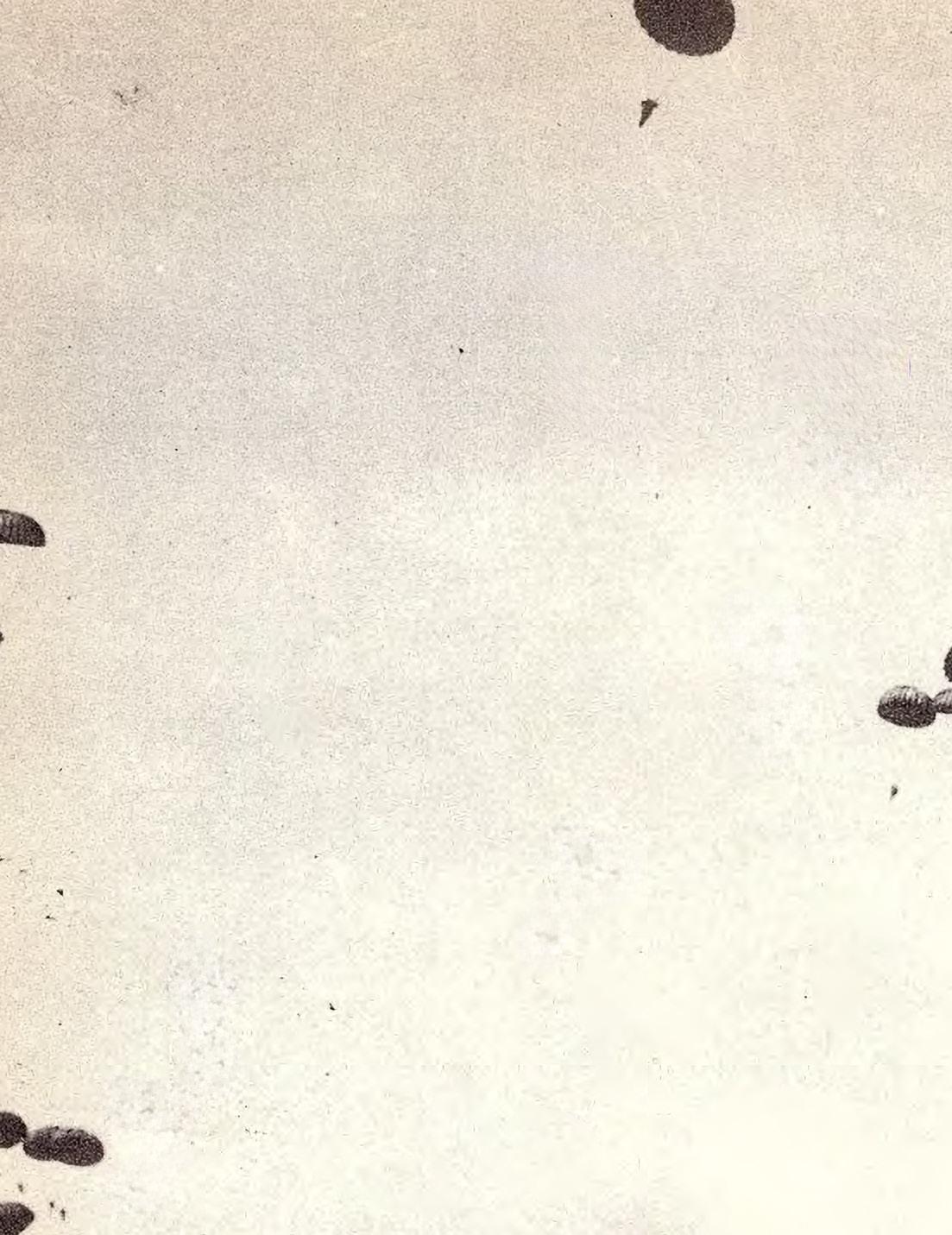



Getting the Drop
Courtesy
Airborne Museum
The 82nd Airborne flawlessly parachuted into Holland in September 1944 as part of Operation Market Garden.

What happened to their baseball dreams?
They had played ball in the 1930s and up until ’41 when they were either drafted or enlisted in Uncle Sam’s army (Lefty was drafted his first day of major league spring practice). They volunteered for the relatively new paratrooper divisions—every paratrooper was a volunteer. These men filled out the 82nd Airborne Division, a storied unit from WWI. It was called the All-American Division and boasted men from all forty-eight states. Recreated for WWII, it became the 82nd Airborne. They were in the 508th Parachute Infantry Regiment of the 82nd and they named themselves the Red Devils.
The Devils in the Details of War
The 508th was one of four PIRs in the 82nd Airborne. In late 1942, the 508th was moved from Georgia to Fort Bragg near Fayetteville for jump training. The camp had superior facilities and an airfield supporting three-runways.
Baseball historian Gary Bedingfield noted, “With more than 100 military installations operating fiercely competitive sports programs for troops during World War II, North Carolina was a veritable gold mine of baseball talent.”
Heroes in Uniform
Lefty Brewer (top), a natural-born leader who was killed on D-Day, in his Washington Senators uniform on the first day of spring training when he got his draft notice; Matthew Ridgeway was the first to take raw infantry recruits and turn them into an airborne division.

The para volunteers sent to Ft. Bragg’s adjunct, Camp Mackall, brought their bare essentials: toiletries, army uniforms, baseballs, and gloves. After a day of rigorous training, the troopers tossed a ball around. It wasn’t long before one outfit challenged another to a real game. The camp athletic officer organized a league and set a schedule. The Red Devils lost their first three games. They reorganized and went on a win streak, finishing the season with a 26-4 won-lost record to capture the Ft. Bragg-Camp Mackall championship. Okey Mills threw a no-hitter in the final game.
The 508th ball team was ready for a road trip, which included a game pitting them against the Norfolk Naval Training Station with major leaguers Phil Rizzuto and Dom DiMaggio in their line-up. But a regimental order ended the season for the Red Devils team. Officers explained that it was imperative that military training be the primary focus. The players were miffed at missing an away game.
They would get their away game. But, the summer of 1943 champs-of-the-camp Red Devils had no idea that their next game would be played 3,600 miles away amid the devastation of bombtorn England.
Let’s look at the leaders who shipped the 508th to England. Set your Way-Back Machine to 1917, West Point. Cadet Mathew Ridgeway is graduating. Ridgeway was given command of the 82nd Airborne. All officers and men who served with and under Ridgeway used the words “awe” and “admiration” to describe him. He was worshipped by all in the 82nd. His training regime was brutal, but it weeded out those who couldn’t measure up. The survivors felt tough enough to whip the enemy bare-handed, and demonstrated that ability in a number of Fayetteville bars. Soldiers invented nicknames for those in command and, for his habit of hanging two grenades on his chest so they dangled strategically over his chest, Ridgeway was
Courtesy 82nd Airborne Museum
affectionately called “Old Iron Tits” behind his back. Expressing strong-held beliefs regarding what might influence unit success, he stated, “That’s the key to the whole thing—leadership.”
Ridgeway was handed raw recruits and charged with turning an infantry division into an airborne division, a military tactic that was entirely new to the US Army and to him. He would lead the 82nd Airborne until given command of XVII Corps that included all US airborne divisions and the British Glider Command.
Reset the Way-Back Machine again, this time to 1907, Brooklyn. A baby was placed in an orphanage. He was adopted by coal miner Martin Gavin and his wife, and named James. Throughout his life, James Gavin enjoyed the gift of being in the right place at the right time. Raised in Mount Carmel, Pennsylvania, he quit school after eighth grade and took a job outside the mines. At seventeen he ran away from home to join the Army. Gavin spent off-duty time reading military history. He entered West Point and became a student of tactics. Offered a chance for paratroop training, he jumped. Gavin was in the army for fourteen years to reach captain, then five years from captain to major. Major to two-star general commanding the 82nd Airborne took just three years. His credo to officers of the division was, “Officers are first to jump; last to eat.” Gavin jumped first man out in four WWII combat jumps. His rating from troopers who served under him was simply, “We loved him. We would have followed him into Hell.” “Jumpin’ Jim” Gavin was a carbon-copy of Ridgeway.
Ridgeway, a “by the book” type officer, was tasked with literally inventing the American Airborne corps. A frustrated leader complained at a staff meeting, “Do any of you know anything about parachutes?” Gavin offered, “Yessir, I have been training paratroopers and I am parachute certified.” Ridgeway asked, “Well, do they have a book on airborne tactics?” Gavin responded, “Yessir. I wrote it.”
The Game
The Red Devils completed training and were moved across the Pond. Based near Nottingham, all men of the division knew the invasion of France was nearing, but only officers knew the time and place. When offered a chance to play a baseball game for a British crowd, Ridgeway’s Red Devils couldn’t wait. They would be pitted against Gavin’s 505th Panthers.

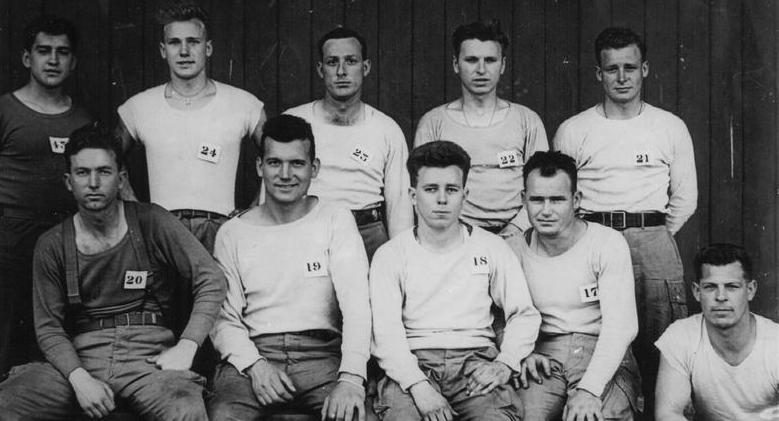
continued from page 9
While the 508th ball team had been winning games in the summer of 1943, the 505th was in combat. Their jumps into Sicily and then Salerno during the Italian campaign had proven the efficacy and value of airborne troop drops into battle zones. The 505th, bloodied in battle, knew that first-hand. Forty miles north of Nottingham, 505th replacements were in training—some to complete parachute certification. They were at an airfield where runways were packed with C-47 transport planes. All airborne troops were sequestered on base, honing themselves to a sharp edge—except the troops in the game at Nottingham.
Baseball historian Bedingfield outlined some details of that baseball game in Nottingham. The big day was Sunday, May 28, 1944, in the afternoon, just a few days before the invasion of France. The Red Devils and the Panthers squared off in front of seven thousand fans at Meadow Lane soccer stadium.
Most historians believe that the ball game was an intentional diversion. The “official” purpose was dubious at best. It was said that the Nottingham Anglo-American Committee had asked the American forces to put on a sporting event because live entertainment had been absent from Nottingham for years. There was lots of pre-game publicity encouraging Notts to attend. The
Eight days after their baseball game in Nottingham in 1944, the 508th Parachute Infantry Red Devils jumped into Normandy.
crowd featured the Lord High Mayor and the Sheriff of Nottingham. The remainder of attendees were all locals save for a number of Yank officers. All other paratroopers were training to the north. The D-Day invasion was imminent, and it was thought that the Germans would surmise it was not about to happen if paratroopers were playing a very public ball game. Someone suggested ball uniforms, but someone else decided that it must be clear it was paratroopers who were playing. The players were made to wear their jump boots, bloused combat fatigues, and a T-shirt. Numbers scribbled on a four-inch by four-inch paper square were pinned to their shirts.
The Red Devils determined that everybody would play so that they could tell the folks back home they had played in the first baseball game in England. “First” was what they were told, and first was what the players bragged about for years. The game was publicized to the point that players’ hometown papers were sent photographs.
The Panthers batted first. Okey Mills was the Red Devils starting pitcher; Walt Lupton catching. Lefty Brewer relieved Mills in the middle of the fourth inning. Lefty had once, in a pro game, picked off the first three batters to reach first base. Some say it was intentional, but he walked the first batter. Then he promptly picked off the runner. No
other batters reached first. The response by the audience confused the players. The Brits did not know baseball, so they were silent until the crack of a bat. Then they applauded like they were watching a match at Wimbledon. And clap, they did! The game was a slugfest for the Red Devils who bested the Panthers 18-0. Lee Reisenleiter, remembering the fans, mused, “It must have been hard for them to make sense of it all.”
A Brief 7th Inning Stretch, Then War
On the afternoon of June 4, the troopers gathered at their take-off fields. Then General Dwight D. “Ike” Eisenhower postponed the invasion to June 6. That wait was torture. The men had blackened their faces and double-checked their equipment, and then waited. Some paced like caged tigers; some sought chaplains; most just napped or chatted quietly. At one runway, through the nervous calm, a truck loaded with a band playing dance tunes appeared. Morris Run’s Thomas MacBlane, who had won a dance contest in London, grabbed a buddy and they jitter-bugged. Others in the stick with blackened faces, ammo belts, dangling knives, joined in. A reporter remembered, “It was the damnedest thing I ever saw!”
Strikes on page 12
Aw, Chute!



Friday, November 28, 2025 Downtown Sayre @ 6:30pm




Stroll along our gaslit Main Street and enjoy a unique experience you won’t forget. It’s a festive weekend filled with shopping, activities, and history that will warm your heart and fill you with Christmas Spirit!
Presented by:
shop LOCAL GIFT GUIDE










The Very Model of the Youngest Major General
General Matthew Ridgeway (left) confers with General James Gavin who, at thirty-six, was the youngest brigadier general in the US Army since the Civil War. When he got his second star the next year he was the youngest major general ever.
Strikes continued from page 10
The phrase “if anything can go wrong, it will” matched the fortunes of airborne troops on D-Day. Pathfinders—two-man paratrooper teams dropped before a major assault—had been dropped on-target to employ beacons-transponder to guide pilots. Pilots had some problems. Seventeen thousand airborne troops took part in the D-Day Operation Overlord; 13,000 were American paratroopers. But, among the C-47 pilots, 75 percent had never been under fire and only 20 percent of the pilots had any nighttime experience at all. The first serial, or group, had experienced pilots who rose above the clouds, found the transponder at twenty miles, and saw the beacons at five miles. They were the only serial to hit the drop zone. Though they were too high and too fast (triple their training speed), eighty of the 118 planes dropped within two miles of the drop zone. Ridgeway, first to jump, was where he needed to be to command.
The second wave, led by Gavin and Col. Roy Lindquist, had difficulties. Alerted, the Germans launched treacherous anti-aircraft flak. Planes were enveloped in clouds. Pilots dropped out of formation to avoid collision with other C-47s. Many scattered and became totally lost. A small number were able to follow ground transponders. Pilots had been ordered to not use their transponders. Panicked, many ignored orders and turned transponders on, making ground devices useless. Worse, since the last observation planes’ photos, the Germans had flooded the fields, making the Meredet and Douve rivers look like the Mississippi. Totally lost, many pilots just hit the green light (the signal for paratroopers to jump). Only sixty-three of the 508th’s 132 planes dropped anywhere near the DZ. Many dropped over the flooded marsh areas, where thirty-six men drowned. Two hundred twenty-three troopers were wounded on landing and taken prisoner.

To Honor and Cherish
Ike's personal Honor Guard, including Lt. Thomas D. MacBlane from Morris Run, the leader on the lower right.
One plane was shot down; one plane with twenty souls aboard was never found; seven planes were downed on the return trip to England, and 111 came home with severe flak damage.
But the troopers prevailed. Expecting to be relieved in two weeks, they faced thirty-five days of tough combat before relief. They would be pulled off the line to re-fit and prepare. The 82nd jumped in daylight and perfect formation into Holland, took the Seigfried Line into Germany. Sent to Sissons in France, they were raced to the lines with little equipment for the Battle of the Bulge. The 82nd’s esprit de corps was best demonstrated when a tank pulled up behind a lone soldier. Asked if he was the front, he replied, “I’m the 82nd Airborne and this is as far as the bastards are going.”
After the Bulge, they were raced toward the Baltic to stop the Russians from claiming Denmark. In the process General Gavin captured 150,000. The division had fought 442 days combat in six countries.
Game Over
How did the baseball players do?
Ace pitcher Lefty Brewer was killed in action on D-Day; Bill Maloney KIA the next day; infielder John Judefind killed June 9; Elmer Mertz killed June 13; infielder Rene Croteau KIA July 4; catcher Walt Lupton killed September 18 in Holland; Joe Leki KIA October 1 in Holland; John Barry KIA March 26 in Germany. The Red Devils team earned twenty-seven Purple Hearts. Several went AWOL from the hospital to rejoin the fight. Two ball players, Ken Hook and Paul Pavlick, were wounded on D-Day, captured, and not released until April of 1946.
shop LOCAL GIFT GUIDE

Maple Syrup • Maple Cream • Maple Candy Maple Sugar • Gift Baskets Specialty Items • Glass Bottles Open year round Mon-Fri 10am-5pm & Sat 9am-3pm Tours & Taste-testing Available



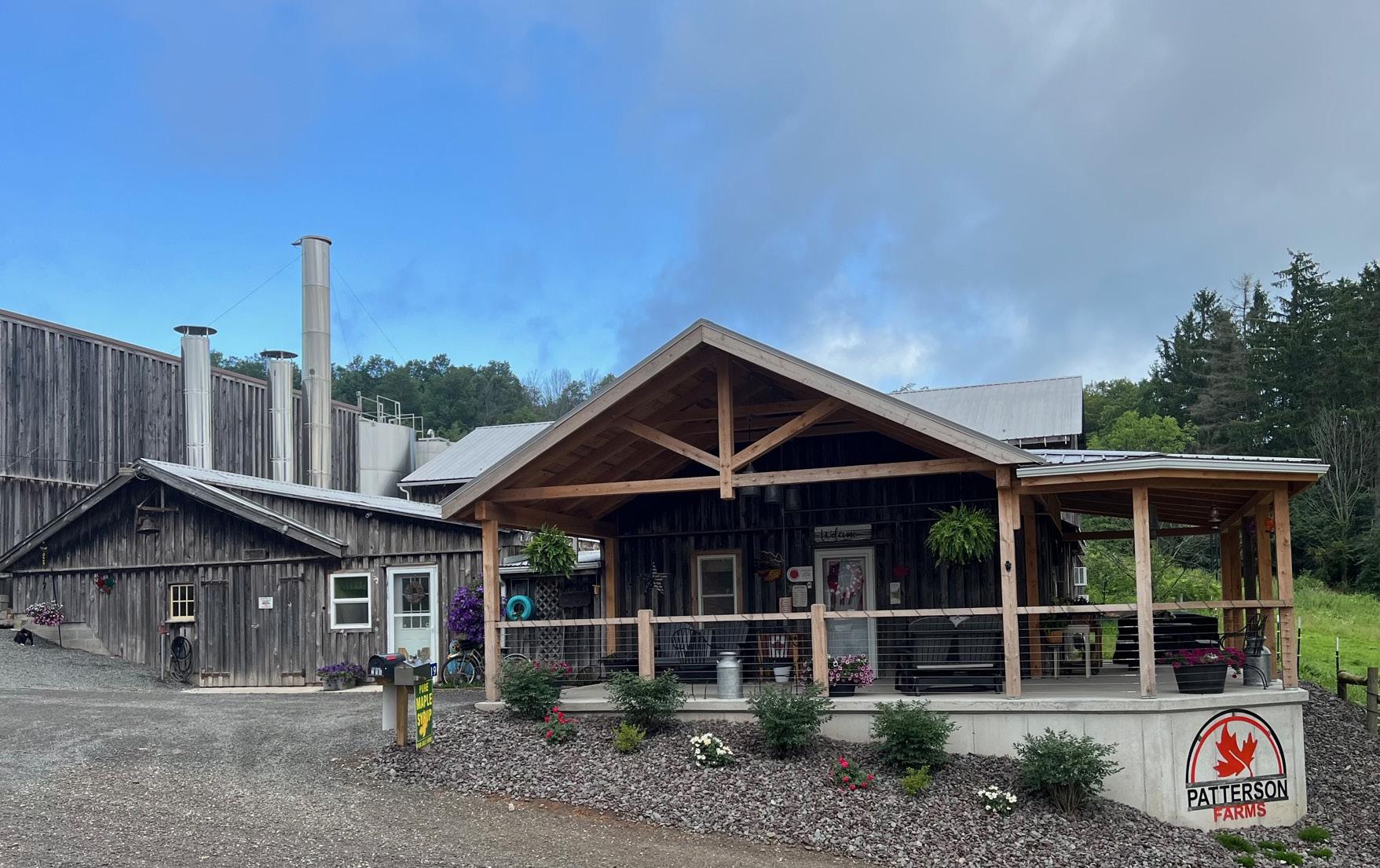


New & Gently Used Formal Wear
One Day Sale for Small Business Saturday! November 29 • 10am-3pm $50 Bridal Gowns, Limited Sizes, Cash & Carry
N. Main Street • Coudersport, PA 814-335-8681 • sewwhizz@yahoo.com Tues, Thurs. & Fri. 9am-5pm; Wed. 9am-3pm or by Appointment



Wild Asaph Outfitters














Over the River and Through the Woods
Veteran Roy Glossner motors through the snow on an Action Trackchair, one of several available to veteran hunters at LEEK Hunting and Mountain Preserve near Oswayo, Potter County.
Hunting and Healing Potter County’s LEEK Helps Veterans
By Paula Piatt
Lifesaver. The word gets thrown around a lot: a friend does you a huge favor; a stranger stops to help you along the side of the road; that small roll of peppermints comes along at just the right time.
Or an Army vet answers the phone and listens to a guy in a very dark place, whose literal last act could have been dialing that phone number.
Now that’s a lifesaver.
Retiring from the Army as a full colonel in 2007 and the new owner of 130 acres in the Northern Tier’s Potter County, Ed Fisher happened upon a story about fly-fishing, Vietnam veterans, and the healing that comes when you put the two together. He remembers telling his wife, Katie—why don’t we try and help these young men and women who are in the hospital suffering from devastating injuries?
“We pulled five guys out [of Walter Reed Hospital in Maryland] for that first hunt in 2008,” he says. Four of them were
amputees, but Ed focused on their abilities, not their disabilities, and provided a friendly, handicapped-accessible camp environment without compromising their current physical limitations.
Ed became a lifesaver.
And now, in its eighteenth year, LEEK Hunting and Mountain Preserve continues to stand by its motto: Serving All Veterans, All Wars (savaw.org, on Facebook, or call (410) 322-4610).
“When I say we’re able to accommodate all disabilities and injuries, we can,” he says, pointing to his fleet of Action Trackchairs that motor through the woods, the hydraulic blinds that lift hunters up in the treestands, and a one-on-one guide service. “We offer a safe environment where these guys can go out in nature and talk each other through the healing process.”
A three-acre pond on the property is always open for catch-and-release fishing. Seven annual hunts—bear, deer, coyote,
turkey, and pheasant—mean a full schedule, and they’ll soon be adding some waterfowling for geese and ducks. Each hunt has a volunteer lead guide responsible for logistics—lining up other guides, dogs for the upland hunts, properties, and enlisting other volunteers. Many are veterans themselves; they know what’s at stake.
“The place, people, and mission; it’s truly a lifesaving and life-changing organization,” says Army First Sgt. Jack Knouse. He was one of the first to experience LEEK’s healing on a doe hunt and now regularly volunteers as someone who’s “been there.”
“[Veterans] connect with other service members who have overcome or are suffering some of the same problems; we help each other out,” Jack says. “I know for a fact that it’s saved multiple lives.”
LEEK, a nod to the wild onion that covers Pennsylvania’s northern forests, asks nothing of the veterans who attend. The four-to-six-day hunts, the accommodations,
and the food are free, all fueled by donations Ed is constantly soliciting for the nonprofit.
“All they have to do is get here. Everything else is paid for. We have the guns, we have clothing that has been donated,” says Ed.
Donations are also fueling the latest project—a 300-seat addition to Dunham Hall, the facility named in memory of Marine Cpl. Jason Dunham, a local Medal of Honor recipient mortally wounded in Iraq in 2004. Construction began this past June, and Ed hopes it will help secure the long-term sustainability of the entire venture. The new space will not only house and serve more veterans annually but will also serve as a revenue source for LEEK.
“It will be available for business conferences, weddings, and a host of other events,” he says. Funds raised go right back into LEEK activities.
As for the property and buildings, their future is secure. As Ed moves into his second decade with LEEK, he knows he won’t be there forever. But he also knows that the program has to; one of the most successful veterans’ outdoor programs in the country won’t end with his passing.
“We’re putting the property into an estate,” he says of the 400 acres and multiple buildings. “My wife and I are donating our entire property to LEEK, so this place will always be protected and always be here for the veterans.”
Back in the hunting blind, nothing is guaranteed—it’s all fairchase hunting—except the experience and bonding with other veterans who have been there.
Shawn Metcalfe, an Air Force Desert Storm veteran, admits coming back into civilian society was not easy.
“I’ll be honest, I was completely lost, and it’s a hard thing for people to understand if they’ve never served,” he says. He’s volunteered at LEEK from day one because he believes in the mission.
“We give them hope that there’s something better other than what they’re dealing with,” says Shawn, who’s now a guide. “If I’m with a guy for three or four days, I make a connection with him. They call me all the time, and I call them, too. We check on each other. you know, to make sure we’re okay.”
That’s the power of the Book. Anyone who’s ever joined a LEEK hunt can sign “22 A Day,” a list of names and telephone numbers dedicated to the twenty-two veterans who lose their lives to suicide each day.
“Once you sign the Book, you’ve also agreed to take a phone call. You don’t have to do anything else, just listen. Some of these guys, that’s all they want, is to know that someone is there on the line with them,” says Ed. “One of my volunteers recently got a phone call. It was a simple ‘thank you’ from the veteran who, in a very dark place, heard the words he needed to hear. ‘You saved my life,’ he said. When somebody says that to you and you know this program is the catalyst for those types of conversations, well, that’s so impactful.”
You could say…lifesaving. Paula Piatt lives in the Northern Tier of Pennsylvania with her husband and two Labrador retrievers, where they hunt and enjoy the outdoors. An award-winning writer and member of the Dog Writers Association of America, she is an active member of the Pennsylvania Outdoor Writers Association.


ATTENTION HUNTERS!
81 acres of woodsy splendor in the heart of Finger Lakes Region. Very private and bordered by state land. Perfect hunting club, recreational or building site. Timber and gas rights convey.
114 E. High St., Painted Post, NY • rwintersre@stny.rr.com









If You've Got It, Flaut It
Director Tina Sochia conducts the Corning Area Community Concert Band as they rehearse for their November 9 concert.
And the Band Played On Still Tooting Corning’s Horn
By David Higgins
1975: Pet Rocks and Gerald Ford. Laverne & Shirley and the Captain & Tennille.
Carlton Fisk’s game-winning home run. They’re all distant memories now, but one local cultural institution, founded that very same year, is going stronger than ever. It’s the Corning Area Community Concert Band, and it will ring in its golden anniversary with a concert on Sunday, November 9, at the Corning Museum of Glass auditorium.
The band was founded to help celebrate America’s 1976 bicentennial, which was a grand time for expressing civic and national pride. Originally dubbed the Corning Kiwanis Bicentennial Band, it quickly accumulated fifty-two members, with Bill Pillar at the helm. Back then, as now, it specialized in the inspiring melodies and toe-tapping rhythms of the best in traditional concert band music. It serves to this day as a reflection of our neighborhood, community, and national ideals.
The CACCB currently numbers sixty-five members of all ages and walks of life, ranging from students to senior citizens and amateurs to professionals. Remarkably, three of the original band are still playing these fifty years later: Geoff Boettner (euphonium), John Cherell (trumpet), and Jim Trondson (trombone).
“It’s been a long and pleasurable journey,” says Jim. “Every week at rehearsals, I’m
surrounded by friends and memories. And after all that hyperventilating from playing the trombone, I’m quite elated to be part of that amazing sound!”
The capstone of the concert will be the debut performance of “The Glass Wilderness” by guest conductor Rossano Galante, who composed the piece specially for the occasion. Rossano, a Buffalo native (yes, he’s a Bills fan), is a graduate of the University of Southern California and studied under Oscar-winning composer Jerry Goldsmith. He has orchestrated numerous big-budget films and television series, such as The Wolverine, A Good Day to Die Hard, and Fantastic Four. He has written almost eighty commissions for ensembles and orchestras throughout the country, and his works have been published worldwide. His compositions are widely performed, and have received rave reviews from colleagues, professors, and students alike.
Rossano says that “The Glass Wilderness” was inspired by both the Corning Museum of Glass and its setting in the lush pastoral landscape of the Finger Lakes. “I was encouraged by CACCB director Tina Sochia to write something about the museum,” he explains. “I wanted to create some lyrical, heroic themes to capture the beauty and grandeur of this marvelous city, Corning. It’s a challenging composition, but I’ve worked with the CAC-
CB in the past and I knew they’d be able to tackle it.”
But wait, there’s more: the band will also perform three other Galante compositions, including “Existence Infinite,” which is being dedicated to founding member Ken Salisbury, who passed away in January.
Rounding out the program are representative selections sampled from the band’s five decades of history; they will please and tantalize all ages and tastes. There will be familiar classics such as Leonard Bernstein’s overture to Candide, Aaron Copland’s “Fanfare for the Common Man,” and John Philip Sousa’s stirring ode to the Marine Corps, “Semper Fidelis” (you’ll recognize it immediately). Another favorite is “American Riversongs,” a medley in a folksong setting; it’s a tribute to the role of our rivers and canals in the growth of the nation.
The November concert doubles as the main fundraiser for the annual CACCB Scholarship, a thousand-dollar prize awarded since 1990 to a talented high school senior musician. The (strictly voluntary) donations collected at the concert are used to fund it. The winner is usually announced at a spring concert at the high school of the winning musician. And thus, the torch is passed to the younger generation, some of whom will surely
Wade Spencer









16
be playing in the 100th anniversary concert in 2075!
The band travels, and has delighted folks in dozens of local concerts and brightened lives in many senior living facilities in Corning, Bath, Elmira, and Watkins Glen. Some notable venues include the Glenn H. Curtiss Museum in Hammondsport, the National Soaring Museum in Big Flats, and a special performance at the Corning Museum of Glass to commemorate their renowned GlassBarge traveling the length of the Erie Canal for that waterway’s 2017 bicentennial.
A rather unusual highlight came in October 1995, at the ribbon-cutting of the I-86 bypass around the city of Corning; the band played in folding chairs on the brand-new asphalt highway! Another memorable gig came in 1999 at the grand opening of the new Dormann Library in Bath. The two speakers that day were former president Gerald Ford and retired CBS news anchor Walter Cronkite.
The CACCB also collaborates with many other community bands and ensembles from across the region: Hornell, Ithaca, Honeoye Falls/Lima, Elmira College, and Commonwealth University-Mansfield, and with Williamsport’s famous Repasz Band, which dates back to 1831. It helps mentor and nurture the younger generation by performing “Adopt a Band” concerts with high school musicians in Steuben, Schuyler, and Chemung counties. Many band members are themselves educators in our local school systems.
And oh, by the way, the musicians are not paid. They’re in it just for the innate joy of making music. They practice for countless hours, at home and in weekly rehearsals, because the whole is truly greater than the sum of its parts. Eighty-plus past and current members will be performing at the anniversary concert, so the memories, and quite possibly some tears, will flow.
“This is the best the band has ever been,” says Jim, the trombonist and fifty-year member—and he should know.
The November 9 concert begins at 3 p.m., and it’s free to all by its very nature. There is no dress code; come as you are.

David Higgins is from the small town of Deposit, New York. He retired in 2021 from Corning Community College, where he taught art for thirty years. Band


GO THE DISTANCE.
Drive into your local Kubota dealership to shop Kubota Genuine Parts.

Courtesy Jim Hyland

Eager for Sure
These brave young men, including Elwood Brotzman (third from the right), all survived the war: five were German POWs after having been shot down, and four completed twenty-five combat missions.
Here they stand in front of a Boeing B-17F in England, 1942.
The Cost of Our Wild Places
The Greatest Generation Includes Our CCC Boys
By Jim Hyland
Uncle Elwood was born on March 25, 1920, near Laceyville, Pennsylvania, and sprouted up on the family farm with his two brothers and the cows and the crops. He ended up smallish, but fearless, and with a big smile and a bigger heart. When his farm work was done, young Elwood loved to hunt, fish, and spend time enjoying the fields and forests that had sustained his family.
After the attack on Pearl Harbor in 1941, Elwood, like many young men and women, felt drawn to serve. He enlisted in the US Army Air Force, and, after stateside training, found himself in Thurleigh, England, amidst hundreds of other brave young men from around the country who had been trained to fly missions on the B-17 Flying Fortress aircraft that were based in southeast England, just across the English Channel from German-occupied France.
“I was real familiar with guns and shooting and machinery, having grown up on the farm,” he told me. “Most of us rural kids were.”
Elwood, because he was so comfortable with the operation and maintenance of fire-
arms and things mechanical, and because he could fit in the tiny tail gunner’s compartment of a B-17, was a natural for the job.
The B-17 Flying Fortress truly was aptly named. To defend her crew and bomb load, the B-17 carried ten to thirteen Browning .50 caliber machine guns that were capable of firing over 500 rounds per minute each.
While on his assigned plane, the Eager Beaver (stored post-war in Montoursville for many years), Elwood sat in the tail section on a leather bicycle-type seat facing the rear. His twin Brownings were mounted just in front of him, and he aimed at attacking enemy planes through the square, supposedly bulletproof, glass windows above the guns. Temperatures in the aircraft would often drop below -30 degrees Fahrenheit, and missions would last up to ten hours.
On April 17, 1943, Elwood was pinch-hitting as a tail gunner on the Little Savage, another plane in his squadron which had lost its tail gunner on a previous mission. Yeah, no comfort there! Anyway, the mission at hand was to bomb the Focke-Wulf airplane
plant at Bremen, Germany, where the Fw 190 fighter airplane was manufactured. The Fw 190 is considered by many aviation historians to be the finest fighter plane of WWII. The Germans defended the factory heavily, and the Little Savage was the only one out of six in its squadron to make it back to England.
Elwood was knocked unconscious when a chunk of his bulletproof glass was blasted into his forehead by a Luftwaffe machine gun. But the Little Savage sputtered home with two of four engines shot out, a piece of the wing and rudder missing, and over two thousand holes in the fuselage.
Undaunted by his experiences, in one month Elwood was out of the hospital and at it again.
This time, he was filling in as a right-side gunner on an unnamed B-17 that was flying to bomb the naval yard at Wilhelmshaven, Germany, on the North Sea. It was his twenty-fifth mission, after which he would have been eligible to go home to the beloved Bradford County farm.















As the plane approached the target, enemy fighters swarmed relentlessly, and flak cannons boomed from below. A flak shell made a direct hit on Elwood’s plane, sending it into a flat spin. Elwood barely got out with time enough to open his parachute, having been pinned to the interior by centrifugal force. A minute later, he was on the ground in Wilhelmshaven, near the town square, unfortunately. He was quickly pistol-whipped, thrown into a wagon, then imprisoned. He would have to endure two years of starvation and brutality until brave Americans and Brits fought their way across France and Germany to free him in the spring of 1945. Uncle Elwood married Mabel, the English nurse who took care of him while he was in the hospital in London following his injuries over Bremen. She waited for him, not knowing if he was dead or alive.
Hundreds of the young men fighting across France and Germany were formerly Civilian Conservation Corps—CCC boys—from camps in what we now call the Pennsylvania Wilds. In fact, there is a picture of one of them at the American military museum in Normandy, France, and it is life-sized and very moving. He is being pulled from the surf after his landing craft had been sunk by enemy gunfire on D-Day plus one. His name is Nick Russin, and, prior to joining the Army, he had been in CCC camps at Coudersport and Darling Run/Asaph.
I was fortunate to speak to quite a few CCC boys during my career as a Department of Conservation and Natural Resources forester. One remarkable man named Ted Niedzwieki had been in the CCC camp at Dyer Farm, in Potter County. He ended up as a navigator on a B-29 Superfortress and flew bombing runs over mainland Japan. He became very emotional when he told me that four of the five really good buddies he had made at the Dyer Camp had never made it home from WWII.
Mr. Niedzwiecki retired after twenty-four years of service as a B-29 master sergeant with the 20th Air Force on the island of Saipan, one of the islands that was captured at high cost by young Americans in the Pacific theater. He lived to age ninety-five, and passed on in 2017.



Those are the stories of the price just a few of our fellow Pennsylvanians paid for the lifestyle and wild places we enjoy. There are many others. Some stories are still unfolding today overseas, and many are gone without ever having been told. Uncle Elwood didn’t tell his until his last years.
We’ve all heard the cliché “freedom isn’t free,” but all Americans must continue to understand these simple words. The next time you’re out in our forests, remember that the solitude, beauty, serenity, and peace you feel was, and is presently, paid for with the strength, sweat, bravery, and blood of those who defend our great country with their lives.

Jim Hyland worked his entire career as a PA DCNR forester in the beautiful north central region of the state. There, he forged a strong appreciation of the people and the woodlands they value and enjoy. Most recently, he was the district forester in the Tioga State Forest, headquartered in Wellsboro, Tioga County.





















































Nessmuking About

Welcome to the Hotels Pennsylvania
By Lilace Mellin Guignard
I’m a townie who moved to the area in my late thirties and started hunting in my early fifties. First I hunted from tree stands on generous friends’ property. As I met more hunters, I was invited to hunt from a friend’s one-person tower stand that silently rotated to let me survey the paths to my left and right. Still, I envied those with elevated shootin’ shacks that evolved from tree stands, then left the tree behind to become clubhouses on stilts. I’d seen them peeking from the edge of fields. I’d heard stories about elaborate ones and imagined them being full of overly masculine and tacky knick-knacks, like when Ken takes over Barbie’s Dream House in the 2023 movie, making it his Mojo Dojo Casa House.
I first checked into the Hotel in 2022. It is much more understated than Ken’s fantasy. Like any good hotel, it provides comfort, and you need to make reservations. However, it is by invitation only. When I got to know the proprietor, Roger Kingsley, he invited me to use one of his DMAP tags to kill a doe on his farm and “booked” me an afternoon slot. The Hotel is about eight hundred yards from the house; the floor is sixteen feet high. I climbed up to the small
back deck, flipped the silent wooden latch, and pulled the antler handle to reveal a carpeted 36-square-foot room holding two padded office chairs tucked up to a shooting bench under a double window. Roger opened the right window because I’m a left-handed shooter, and stacked pieces of wood and a sandbag to customize my rifle prop. Then we waited. The wind was mostly blocked, and we could even whisper some. I got a good-sized doe that day and could still feel my toes.
Roger grew up farming this land and built the original shack in this spot because the shooting lane straight ahead was an access road to the high field where they always saw deer bedding or crossing. It was 2008, the year his family sold the cows, and he had more time to hunt. He also became a grandfather that year. The first crude structure was a test, but soon his hunch about the spot was confirmed. That structure was smaller with no plexiglass, so the only way to see was unboarding the windows. In the first ten years, he cleared six more lanes spoking out, counting the first access road as 12:00—the Dead Zone. Here his sixyear-old grandson shot his first deer with a crossbow.
In 2018 he remodeled it, doubling the floor plan into what it is today. “It was inevitable that this was going to get bigger,” he says, “because I was going to be spending lots of time with the grandkids.” He claims he’s not a very talented carpenter but can get the job done. “I wanted to be able to sit here in brutal weather and still see out.” He also needed space and concealment because “kids can’t sit still.”
While hunting with his grandkids is the main motivation, Roger shares his shootin’ shacks with others like me. Last year twenty-seven folks hunted from his eleven stands scattered about, but the Hotel is the grandest and “killingest.” A sign on the wall says, “Welcome to the Hotel” and lists the amenities and rules, with his phone number underneath. A digital clock gives indoor and outdoor temps. The place is clean, with a couple tasteful wall decorations over the gun rack. Here the odds are good, and the view is exceptional. Recently he watched a ruffed grouse tell off a yearling deer who was probably getting too close to the babies. Roger’s video shows the yearling putting its head down and jumping around, causing the grouse to jump, sometimes bopping the deer in the head.
Lilace Mellin Guignard
I ask him if he ever sleeps in the Hotel, because that’s what I’d be tempted to do. He looks at me like that’s silly, given he has a comfortable bed nearby and a side-by-side to get him there quick. Fair point.
I’ve never hunted with my friend, whom I’ll call Daniel Boone for his privacy, but whenever we talked hunting, he’d give me updates on his Redneck Hotel. Over the years it got higher, ’til he was toying with the idea of putting a hot tub on the roof deck. He had other shootin’ shacks on the property he and his wife bought about ten years ago, but they’d first built this as a one-level space with room to hang out and have a broad view of the valley.
When I got up the nerve to ask for a tour, he drove me to it. The bottom floor is almost the size of a single wide, and real windows with no screens face the valley field surrounded by trees. Like Roger’s, there’s no insulation or electricity. There’s a cooler at one end, with food and drinks for hunters needing to take a break, even if they’re at other stands and blinds on the property. This is the center, the heart of the hunt.
On the wall between the two main windows is a watercolor of a bobcat in the Pennsylvania hills. He hung this painting because it reminds him of growing up and hunting near Gaines with friends. His mom would give him plastic bread bags to put over his socks to keep his feet dry, and his dad gave him Sternos to warm his hands enough that he could shoot. “I thought, ‘No way my grandkids are doing that,’” he tells me. One of his grandsons shot his first deer and turkey from here. He invites some fathers with young children to bring their sons hunting. “They’re so busy. This gives them a chance to make these kinds of memories.”
At the end of the first level, he’s erected a square tower. A wooden staircase, listing to the right, leads to the second level. Boone grins, expecting my reaction, and says, “Everything is completely safe, but not completely square.” He and his grandson do most of the work, calling themselves Close Enough Construction. The second level doesn’t have room for more than the staircase opening and a narrow landing, so they decided to start using ladders. Because of that, the third level has room for a twin bed. Another ladder and we’re at the fourth level, with an easy chair bigger than the opening at the ladder. Boone likes to come here at night, listen to audiobooks until he falls asleep, then wake up at dawn to see the wildlife below.
Up one more ladder and we’re on the roof with a chest-high railing. Now I can see there are deer on the knoll behind us. He says, “To me, all this is so much more fun than hunting. I love to hunt, don’t get me wrong, but I don’t care if I shoot anything anymore.”
Seems to me these grampas are enjoying being kids again with their grandkids, whether they’re hunting or not. Boone has one shootin’ shack that his granddaughter calls her treehouse because he put all her play furniture in it when she was little.
“When we were kids, we built forts,” Roger says about himself and his brother. Then he laughs. “And boy, if we’d had this kind of thing when we were kids we definitely would have slept here!” Boone says building forts is more fun when you’re older and you can afford the materials you want.
Apparently, some grown-up Kens build their own Dream Houses. And pass those dreams down.



Town
Spectacular family-oriented drive-through holiday music and light show.
Over a mile of light displays!
Travel at your own pace and see your favorite Christmas scenes come to life in brilliant LED lights!





Kurtis Martin is proud to run Black Creek Sports in Liberty with his sons, Tyler (center) and Konnor (right), where they offer a full range of gear and support for archery hunters; Tyler (far left) operates their drone with thermal imaging that can reveal deer habits to private landowners.

Black Creek Sports Hits the Mark
As Interest in Archery Grows, So Does This Liberty Business
By Chris Espenshade
To the area archers (or archer wannabes) who have not yet discovered Black Creek Sports—what are you waiting for? This family-owned, Liberty-based business offers a well-stocked archery pro shop, and the proprietors—Kurtis Martin along with his two eldest sons, Tyler and Konnor—are there to provide sales, maintenance, repairs, and tuning of all types of bows and crossbows.
The store, at 8020 Route 414, about a mile west of Route 15, evolved from a nearly twenty-year-old business the Martins already operated.
“We moved here in 2006 and established Black Creek Enterprises,” Kurtis explains. “That’s more of a construction company. We sell some outdoor storage sheds, that type of thing. And then we established Black Creek Sports as a division of Black Creek Enterprises initially to sell and distribute 360 hunting blinds.”
From the earliest days of Black Creek Enterprises, their service included seeds, advice, and labor for feed plot management. The deer blinds and feed plot management supplies attracted hunters to the business, and Black Creek Sports was created three years ago. The plan was to create a generalized hunting and fishing retail establishment, but customer requests quickly identified their niche.
“We had a little bit of everything, and we still do, but it became obvious pretty quick that archery’s the main interest around here,” Kurtis says. “And there was a need.”
While the number of firearm hunting licenses has been steady over the past few years, the sale of archery licenses continues to grow. In addition to hunting, other areas in archery have seen new popularity. According to a 2020 study by the Archery Trade Association, 4 percent of Americans over thirteen years old participated in bow hunting, 7 percent were
active in recreational archery, and 2 percent pursued competitive archery.
“The archery pro shop started about three years ago,” Tyler notes. “We just got Matthews and Hoyt earlier this year.” Bear is another line of bows they carry, as well as Ravin and Ten Point crossbows. They sell recurve bows, compound bows, crossbows, plus the full range of archery accessories.
The Martins are particularly proud of the pro shop. Konnor and Tyler have both been trained in archery maintenance, repair, and adjustment, and Konnor has earned the title of certified bow technician from the Archery Trade Association. In addition to string replacement and sight installations, Black Creek Sports cuts and fletches arrows. With a twenty-yard indoor range sporting paper and 3D targets, they can work closely with customers to maximize the fit and sighting of equipment.
(2)
Chris Espenshade
Upping Your Game

Wheel Inn Inc.


Upcoming Events
• Nov. 14: Jacob Gilpin, 6pm-8pm
• Nov. 22: Just Cause, 6pm-9pm
• Dec. 12: Just Cause 6pm-9pm w/Wiggle 100 Money Tree from 6pm-8pm Open Wednesday-Sunday








Kurtis is clearly a proud father when discussing the importance of and attention to customer service.
“There was a guy who called in yesterday morning,” Kurtis relates. “He’s leaving Tuesday morning on a hunting trip. I can’t remember where he’s going. He’s coming in in about half an hour when we open at nine o’clock. He had his crossbow and it badly needs new strings. He had it at another archery shop, and they weren’t getting it done. And so, he’s calling around—does anybody have strings for this thing? We were able to get some the same day. That was yesterday. He’s coming in this morning. We’re getting him fixed up so he can go on a hunting trip on Tuesday. He is thrilled. He will be a customer for life.”
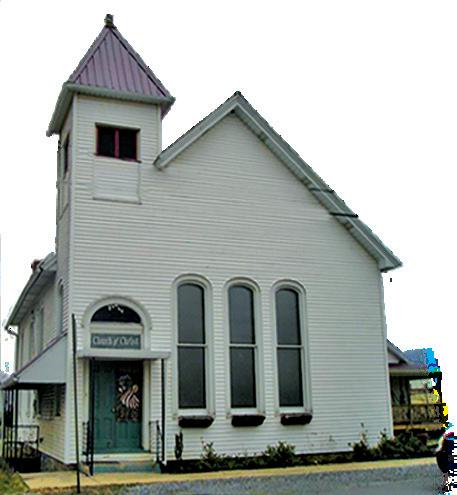






While Konnor leads the archery efforts, Tyler focuses instead on characterizing and improving private game lands. Black Creek Sports has the seed, equipment, and expertise to improve the health of deer herds through the creation of game feed plots. With their no-till planting drills, Tyler can sow a game plot without the dust and erosion associated with plow-based approaches.
In another effort to better inform landowners of their deer resources, Black Creek Sports has invested in a drone with thermal imaging, and Tyler has received his drone pilot license. He flies the drone over woods behind the shop. Even though it was flying at 300-400 feet to avoid spooking or harassing wildlife, the heat signals of eight to ten deer were visible real-time.
Then, using the drone’s zoom camera, Tyler was able to distinguish between bucks and does. This type of herd characterization flight can be completed over many acres quickly, providing the landowner or hunting camp with data on herd composition and their favored habitat.
Tyler would like to see the Pennsylvania Game Commission legalize the use of drones to locate lost deer. Each year in the Keystone State, thousands of deer are shot but not recovered. A drone with thermal imaging could quickly cover a search area and identify the dead or wounded deer, allowing its timely recovery. In Ohio, where drone recovery is legal, success rates exceed ninety percent. The drone can also be used to find stray pets or lost/injured people.
Black Creek Sports also sells e-bikes for the back country. They handle the Rambo and Fission brands, and see these bikes as allowing people to hunt away from the road despite health or age. Folks who might formerly have relied on noisy, smelly ATVs to access the far blinds can now use an e-bike with a range of forty to fifty miles.
The store sponsors a big buck contest (this is the third year), and sells ammunition and fishing supplies. Kurtis is pleased to state the obvious—“We’re really quite busy.”
Find out more at blackcreeksports.com, or reach the store by phone at (570) 324-6503. Better yet, drop by between 8 a.m. and 5 p.m., Monday through Friday, and 8 a.m. to noon on Saturdays.


Holiday Happenings



























High on the Mountain
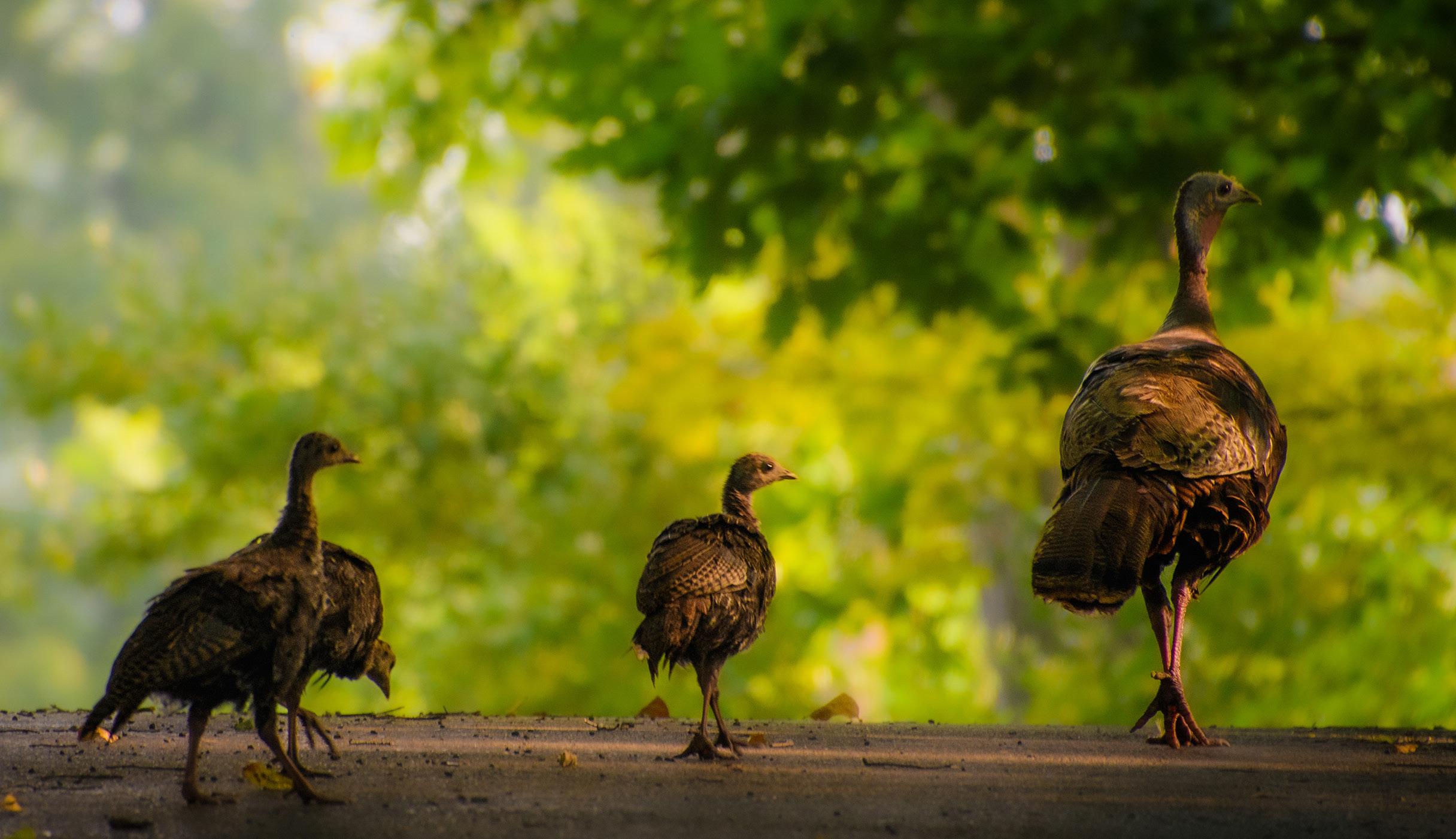
The Art of Patience
By Matthew Stevens
I’ve always believed that photography isn’t just about pressing the shutter; it’s about building a relationship with light, with the land, and with whatever living thing happens to cross your path. Sometimes that relationship is built in an instant. Sometimes, as I’ve learned with Pennsylvania’s wild turkeys, it’s more of a long game.
When most people think of turkeys, they picture the domestic bird on a holiday table. But the wild turkey of Pennsylvania is an entirely different creature—wary, cunning, and built for survival. They move with an uncanny mix of elegance and clumsiness, blending into the forest one second and exploding in a flurry of wings the next. As a photographer, that unpredictability is part of the draw.
My first turkey photograph came by accident. I was setting up for a misty morning landscape when a hen emerged from the treeline, her head darting back and forth with deliberate precision. She didn’t notice me at first, and I had just enough time to adjust my exposure before she froze, staring straight through me, and vanished into the brush. I got two frames, neither perfect, but
those imperfect frames reminded me why I do this. A photograph doesn’t have to be flawless to be meaningful. It has to be honest.
Turkeys have a way of teaching you patience. They don’t perform for the camera. They don’t linger in golden light just because it’s “the shot.” If you want to capture their character, you have to slow down, sink into their world, and wait for them to accept your presence—or at least tolerate it. That’s one of my guiding ideals in photography: let the subject be itself. I’m not there to control or stage the scene. I’m there to witness. If the turkey decides to strut across a shaft of sunlight, that’s a gift. If it melts back into the shadows before I can lift the camera, that’s the story too.
Over the years, I’ve photographed turkeys in every season. Toms in full spring display, bronze feathers catching the morning light like hammered metal. Hens shepherding a line of downy poults through autumn leaves. Wary flocks scratching for food on a January hillside. Each image is less about the bird itself and more about the moment it lives in—the mood of the light, the texture
of the air, the way the forest holds its breath when wildlife passes through.
In the end, photographing wild turkeys has reminded me that the camera is a bridge, not a trophy rack. The goal isn’t to collect shots but to connect—to the animal, to the place, to the fleeting instant when it all comes together.
Those moments, whether caught on film or just in memory, are what keep me walking the ridges and valleys of Pennsylvania, lens at the ready, always listening for the soft rustle of feathers in the undergrowth.

Matthew Stevens, a thirty-six-year-old Marine Corps veteran and lifelong resident of the rugged mountains of northern Pennsylvania, is the owner and photographer of High on the Mountain Photography. With a passion for capturing the natural beauty and untold stories of his home region, he specializes in portrait, event, and nature photography while also volunteering his time to shoot local school sports and community events.
Matthew Stevens


KICK OFF THE 2025 HOLIDAY SEASON IN SAYRE, PA



19th Annual Sayre Turkey Trot 5K
Thursday November 27 • 10am • Downtown Sayre sayreturkeytrot.com • sayreturkeytrot@guthrie.org
27th Annual Sayre Christmas Parade
Friday November 28 • 6:30pm • Downtown Sayre sayreborough.org • parade@sayreborough.org

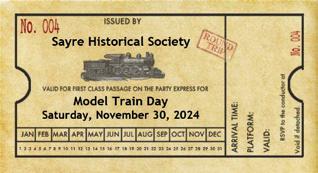
SBA Shop Small Saturday
Saturday November 29 exploresayre.com
SHS Model Train Day
Saturday November 29 • 10:00am SHS Museum • 103 South Lehigh Avenue sayrehistoricalsociety.org
Some events are funded in part by the Bradford County Tourism Agency



au ul ti f Be The CELEBRATING AMERICA’S 250TH BIRTHDAY!
General Ridgeway took command of 8th Army, then became United Nations Supreme Commander in Korea when President Harry Truman fired General Douglas MacArthur. He was Supreme Allied Commander, Europe, NATO. General Gavin stayed in the Army and retired as a three-star at age fifty-one. He later served as US Ambassador to France under President John F. Kennedy.
After VE-Day, the 82nd was chosen as honor guard for Supreme Headquarters Allied Expeditionary Forces. Newly-minted Lt. MacBlane headed Ike’s personal Honor Guard. They invented intricate white lacing on boots, had white belts, gloves, and ascots made from parachute silk. Their bayonets were chromed. Patton was so impressed he said, “Ike, that’s not just your Honor Guard. That’s America’s Guard of Honor.” Thus, the motto of the 82nd became “America’s Guard of Honor.” All members of the 82nd earned the Bronze Star. Some got a second Bronze with “V” for Valor.
Post war, Okey Mills, with two Purple Hearts, finished college and was elected sheriff Raleigh County, West Virginia; Frank Shank played three seasons again for a Cardinals minor league team. Frank Labuda, with a Purple Heart and Bronze Star V, returned home to Chicago Heights where he led the Forest Lake League in RBIs and batting average. George Shenkle, with a Bronze Star V and Purple Heart, was ordained and went into schools to teach students about WWII; Lieutenant Colonel Bud Warneke, regular Army, with a Bronze Star V, Purple Heart, and a battlefield commission, fought in Korea, retiring as Commandant Parachute Training at Ft. Bragg. Leo Matuszewski, with a Purple Heart, spent his life as a Catholic priest; Lieutenant Colonel Thomas MacBlane, with a Bronze Star V and twenty-five years in the Army Reserve, was noted for leadership in Elmira’s community charities.
Years later, though the troopers dodged discussion of deadly battles, members of the 508th baseball team smiled as they remembered that game in Nottingham when their Red Devils trounced the 505th. Because “Peace is what they crave … The one constant through all the years was baseball. Baseball is a part of our past. It reminds us of all that once was good, and could be good again.” So said in Field of Dreams.

Retired teacher, principal, coach, and life-long sportsman Don Knaus is an award-winning outdoor writer and author of Of Woods and Wild Things, a collection of short stories on hunting, fishing, and the outdoors. Strikes continued from page 13
Wade Spencer











BACK OF THE MOUNTAIN

Falling to Grace
By Linda Stager
You may notice the perspective in this photo—yes, I was on the ground. That’s because I wanted to see this scene, the one I have taken so many photos of, from a different perspective. From the ground up, right where the leaves had fallen, I could see that the Wellsboro lamppost and the tree felt so much taller, almost stronger. And St. Paul’s Episcopal Church, settled into the foggy background, seemed to be a quiet reminder of the peace I felt.November is one of my favorite months. As much as I love color, the bareness of this month strips away so many distractions. It lets me see in a different way.






